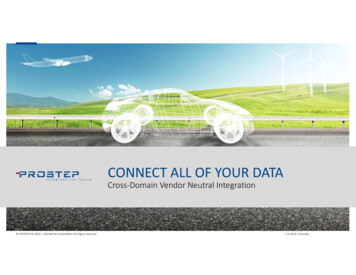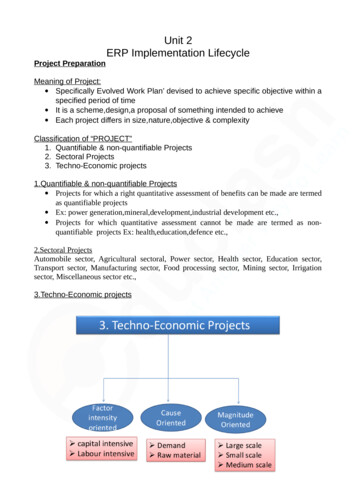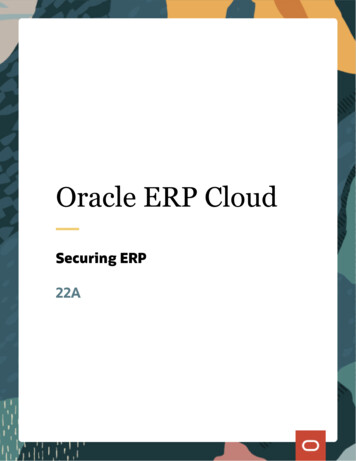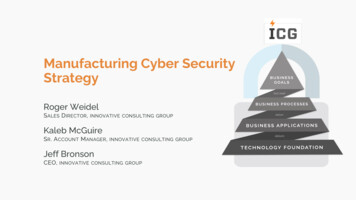
Transcription
Managed cloud servicesfor ERP applications:A comparison guideWhat to look for when choosing your cloudapplication management provider
3Why a managed cloud for ERP?5How does a managed cloud add value?6What should you look for in a provider?8Choice: What are your options?11Security: How protected are your data and applications?14Management: What can a provider actually do for you?17Expertise: How capable is your provider?20Simplicity: How will your provider simplify and optimize your ERP environment?22How does your prospective managed cloud servicesprovider answer these questions?23Free your teams to focus on more strategic projects24Take the next step: Where competitors fall short, we understandthe beginning, transition and destination of your journey to the cloud2
Why a managed cloud for ERP?SAP S/4HANA adoption:The value of a managed cloudWhy a managed cloud?To support critical applications like SAPHowever, many organizations lack the skills toIt’s become clear that SAP S/4HANA isand Oracle, organizations have begun tomake this transformation and take advantagethe next-generation business suite of theadopt cloud services and move away fromof these emerging technologies. A modernfuture for SAP clients. To harness the fulltraditional outsourcing and on-premisesERP environment can be incredibly complex.power of core applications like these, manymodels. Increasingly, they’re recognizing howThat’s why so many enterprises work withenterprises look to combine their adoptioncloud-enabling these workloads is crucial toa managed services provider to take on theof S/4HANA with a move to the cloud. Butenhancing agility and efficiency, which createsresponsibility of skills acquisition, optimizeit can be difficult to find people with thea discipline of business innovation. By movingrepeatable processes and help promote fasterskills to run the process effectively, andcritical, data-intensive enterprise resourceand more accurate deployments that drivethe move can put stress on limitedplanning (ERP) applications to hyperscaleinnovative new services.IT resources.cloud infrastructure, organizations can driveFor SAP S/4HANA, a well-qualifiedapplication performance, scalability andmanaged services provider can helpadaptability. Moving these workloads to cloudreduce these issues. As a dedicated,also empowers teams to integrate emergingtrusted manager of the S/4HANA suite,technologies like AI, the Internet of Thingsa provider speeds time to value by(IoT) and blockchain with the data from theseaccelerating your SAP module adoptioncritical applications.Why a managed cloudand migration. Added value What to look for Choice Security Management Expertise Simplicity Checklist Free your teams Next step3
Why a managed cloud for ERP?Which workloads are bestfor a managed cloud?The benefits of the right managedcloud services provider can:Enterprise applications of all shapes and sizesare a good match for managed cloud services.These services include workloads across theapplication lifecycle, such as developmentand testing, load testing, quality assurance,preproduction, training and stagingenvironments, and production.Given their pivotal role in leading businesstransformation, ERP platforms are primecandidates for managed cloud deployment.These platforms include enterpriseapplications, SAP S/4HANA and otherERP applications not originally developedfor the cloud.Why a managed cloud Added value Help optimize applicationinvestments and provide migrationassistance with deep expertise,assessments and tools.Reduce complexity, time andrisk with trusted, auditableprocesses and controls.Provide insights thathelp you run your solutionmore efficiently.Provide consistent serviceacross leading hyperscalecloud providers.Help deliver consistentapplication performance andvisibility with guaranteedservice levels.Help keep your data andapplications secure withintegrated, built-in security.What to look for Choice Security Management Expertise Simplicity Checklist Free your teams Next step4
How should a managed cloud provider add value?The right cloud managed services providercan help IT departments use predictiveanalytics to drive proactive issue detection andapplication-specific automation. This approachhelps you prioritize and proactively manageissues and events while driving down cycletimes for change requests. A provider can alsosupply tools that enable visibility across datato create actionable insights that help increaseperformance, improve resiliency service levelsand decrease costs.58% of IT leaders describeinnovation as “important”or a “primary factor”in their activities.1Why a managed cloud Added value Using data in new ways to innovate and create competitive advantage or operational efficienciesis key to the success of most enterprises. But a solid technology foundation must be in place.Here’s how a managed cloud service provider can help.Match the environment to the workloadby selecting the appropriate cloud foryour specific workloads while maintainingconsistency across cloud providers.Optimize the application investmentthrough a solution that’s configured,deployed and managed to meet theneeds of your workloads.Simplify operations and gain transparencywith cloud and application performancevisibility that includes features like rapidservice activation and deactivation,infrastructure monitoring and reporting,and security and patch management.Ensure peace of mind using a holistic,integrated approach to security, frominfrastructure to applications, that helpsERP workloads in the cloud meet securitystandards and adhere to data privacycompliance protocols.What to look for Choice Security Management Expertise Simplicity Checklist Free your teams Next step5
What shouldyou look forin a provider?Why a managed cloud Added valueChoosing the right providerto deploy and manage yourapplications in the cloud is not asimple decision. Gaps in security,services, technology, expertiseand the ability to deliver resultscould have serious consequences.A managed cloud provider shouldmeet all your needs, not just some.Focus on the following key areaswhen deciding on a provider. What to look for Choice Security ManagementChoice of cloud infrastructure. Maintain theability to choose between infrastructures—like IBM Cloud , Amazon Web Services(AWS), Microsoft Azure and Oracle CloudInfrastructure—and select the right location,services, delivery and coverage for youroperating systems and hardware runningbusiness-critical applications.High levels of security. Ensure that yourprovider can deliver the security levelsrequired for compliance, with appropriatedivision of responsibility between you andthe provider.Look for a provider with security expertise andcapabilities that are built into the service, notjust added on. These capabilities should be forthe needs of ERP applications tohelp ensure workloads and data remainprotected at all times. See if the providercan demonstrate that its capabilitiesmeet your compliance standards, and itsreporting capabilities can help you meetregulatory requirements.The right provider should be able to matchyour workloads to the infrastructure thatcan best support it and help align businessoutcomes with technology investments.Make sure that your provider offers servicesfor multiple cloud providers and can deliverconsistency in expertise and visibilityacross different platforms. Expertise Simplicity Checklist Free your teams Next step6
What shouldyou look forin a provider?Why a managed cloud Added value End-to-end cloud management. Takeadvantage of a provider’s managementskills, from infrastructure as a service (IaaS)through platform as a service (PaaS) andon to application support.Expertise. Learn from the provider’sexperience in cloud and the workloadsrunning on it, emerging technologies andoperations optimization for increasedreturn on investment (ROI).The right provider goes beyond a basicservice offering to provide added valueby helping with tasks, such as workloadselection and migration, environmentconfiguration, and specialized workloadgovernance and management. It will usetools like automation and AI operations(AIOps) to deliver predictive analytics thatimprove the managed service experience.Depending on the offerings, the providercan even extend your ERP applicationsusing AI, IoT and blockchain.Some providers are focused on technologyalone, tied to a specific platform. Othersoffer services without the deep technologyor operational expertise to get the most outof them. Look for a provider that has a firmunderstanding of emerging technologies, andthe skill to integrate those technologies withERP applications running on cloud, so you getthe most out of your application investment.This breadth of skills, technology and serviceshelps the provider understand your needs,implement the best solution and deliverbusiness advantage.What to look for Choice Security Management Expertise Simplicity Checklist Free your teamsSimplicity. Streamline and simplifyoperations to deliver management,automation, visibility and actionable insightsacross your ERP application landscapes.The right provider provides a level oftransparency that helps drive informeddecisions for targeted outcomes. The digitaltools it offers for activities like communication,service requests and ticket management area key indicator to the level of simplicity theprovider can bring to your applications andworkflows. A rich portal experience or datathat can be consumed through an API aretwo examples. Next step7
ChoiceWhat are your options?Choice of cloud infrastructureas well as location, servicesand delivery—plus coveragefor the operating systems andhardware that run businesscritical applicationsWhy a managed cloud Added valueThe ability to choose theright cloud for the rightworkload is vital and cancreate opportunities forsimplified management,security, governance anddata leveraging.2Not all clouds or cloud providers are createdequal. A cloud managed services providershould be flexible—offering you choices ofIaaS provider, hardware, operating systemand platform components—to align clouddeployments with your unique needs andworkload requirements.Many providers offer a one-size-fits-allinfrastructure that doesn’t necessarily allowyou to achieve optimal price performance.These providers can limit your ability to useexisting skills and resources. Be wary ofproviders that don’t always guarantee highapplication service-level agreements (SLAs)as you deploy mission-critical applicationsand data to the cloud—often, they onlyoffer an off-premises, virtualized publiccloud infrastructure. What to look for Choice Security Management Expertise Simplicity Checklist Free your teams Next step8
Choice“What are my choices for cloud providers?”“Can you meet service levels?”The answer should include operatingenvironments that align with your needs—not the needs of the provider.Q&A:How to know if you’vefound the right providerThe answer should include SLAs thatcover your entire managed cloud. Added value What to look for Choice Security ManagementThe answer should focus on a cloudsolution that provides choice.Some providers only offer SLAs for servers,storage and networking, not to the applicationlevel for workloads like SAP. Such a limitationincreases your organization’s risk by makingyou responsible for bridging the gap. Look fora provider with SLAs that span IaaS and PaaSand extend through the operating systemand application level. Remember: differentworkloads have different SLA requirements.The right provider ensures the guaranteesin your agreements are specific to yourworkloads’ characteristics.As organizations continue to transform andrun ERP applications on third-party clouds,cloud providers impact the end-to-endservice management experience. Theseexperiences no longer depend on resourcesunder the control of your IT department, soyou’ll want to select operating environmentsthat align with your unique needs versus theneeds of the cloud provider.A provider should be able to support a widerange of operating environments, allowingsolutions to complement your existingenvironment and skill set regardless of thecombination of hardware and software. Inaddition, the right provider works with youto match infrastructure and platform servicesto your workload needs, rather than usingfixed-size deployments.Why a managed cloud“Do you manage more than your owncloud platform?” Expertise Simplicity Checklist Free your teamsA managed cloud provider should enable youto deploy your enterprise workloads whereit makes most sense, regardless of cloudprovider. By helping to simplify and streamlinemanagement, you can gain business agilitythat helps you respond to new customerdemands and competitive threats. Next step9
Choice“Can you deliver a consistent experience across my organization?”Q&A:How to know if you’vefound the right providerWhy a managed cloud Added value “How well-qualified are you based on my goals?”The answer should focus on the use of one set of IT managementpractices and a single delivery team worldwide.The answer should demonstrate that the provider is ableto meet your end-to-end needs.To meet customer and business expectations, it’s important to havethe same infrastructure, software, processes and managed servicesin place—especially in a disaster recovery, workload migration or globalenterprise scenario. A cloud managed services provider should focuson delivering consistency across your environment regardless ofwhere it’s deployed. The resulting standardized deployments andservice delivery can reduce risk, decrease complexity and helpassure SLAs are met both locally and globally.Cloud managed services shouldn’t limit your options, yet manyproviders do by depending on third parties. A provider should havethe full range of required knowledge, service portfolio, skills andexperience in-house that are accessible 24x7x365. To get the mostfrom that relationship, look for an option to engage with a single pointof contact that delivers comprehensive, customizable metrics andviews to help you quickly identify and resolve issues. A meaningfulrelationship with a single provider should include professional services,such as strategy development, premigration planning, migrationservices, a choice of delivery models and support for options likeusing your own hardware.What to look for Choice Security Management Expertise Simplicity Checklist Free your teams Next step10
SecurityCan your provider reallyhelp protect your dataand applications?High levels of securityrequired for compliance,with appropriate divisionof responsibility betweenyou and the provider41% of enterprises that currentlyuse multicloud environmentsindicate that security is aprimary challenge.2When you experience a breach in security,your reputation is damaged. Current clientsmay feel their data is unsafe and potentialcustomers may no longer consider you aviable option. Plus, there’s the potentialfor penalties from regulators. While manyproviders claim that their clouds are secure,gaps in infrastructure, services and physicalsecurity could leave you implementingretrofitted sets of fixes in response tobreaches. Depending on a provider’s levelof security expertise—and whether or not itoutsources security options to third parties—you may experience limitations andadditional risks.That’s why a cloud provider should treat yourclient data as if it were its own by buildingsecurity into the design. By integrating a fullrange and multiple layers of security from theprovider itself, you can meet your complianceand data residency needs, and strengthenreporting and vulnerability protections.Why a managed cloud Added value What to look for Choice Security Management Expertise Simplicity Checklist Free your teams Next step11
Security“Where exactly will my data reside?”“What is your approach to data privacy?”The answer should clearly define thelocation of your infrastructure and data.Q&A:The answer should demonstrate the provider’sstrategic approach and how it manages itsdata privacy practices.With some providers, you might not knowmuch about the security and risk exposure ofthe center where your data and applicationsare actually housed. Some data sovereigntyrequirements mandate that certain typesof data be stored in a particular location.How to know if you’vefound the right provider Added value What to look for Choice Security ManagementThe answer should demonstrate qualityin security and compliance.Simply claiming that a cloud is secure and canhelp you meet your compliance obligationsisn’t enough. Since you’re responsible forcompliance with regulatory data privacymandates, like GDPR, your provider shouldhave capabilities that help you meetapplicable standards. Look for certificationsfor ISO 27001, 27018 and 22301 standardsacross all services, not just a select few.Data privacy isn’t a box to be checked off—it’s a strategic and continuous part of thechecks and balances that comprise all of yourbusiness processes. Since security is deeplywoven into your organization, you’ll want toreview the privacy standards of a potentialprovider. The provider’s team should be ableto provide clear and concise responses tohow it aligns with the wide range of privacyregulations around the world like GeneralData Protection Regulation (GDPR) and theCalifornia Consumer Privacy Act (CCPA). Plus,it should be able to explain the best practicesused to maintain data privacy procedures ina shifting regulatory landscape.A provider should keep your data in thesame city where you have agreed it shouldbe placed—on its own infrastructure ratherthan relying on third parties. You’ll also wantto learn about the provider’s secure disasterrecovery sites, so you’ll know where yourdata goes in the event of an outage. Don’tforget that data access is as important aswhere it resides. You’ll want to make sureonly you—and not your provider—have accessto your data to help keep it secure and incompliance with data access regulations.Why a managed cloud“How do I know your security is adequate?” Expertise Simplicity Checklist Free your teamsThese certifications and other securitymeasures should be validated annually byexternal auditors with evidence demonstratedthrough the American Institute of CertifiedPublic Accountants (AICPA) ServiceOrganization Control (SOC) level 1 and 2.A provider should also conduct regularvulnerability scans that cover hardware,software, policies and procedures acrossyour infrastructure. Next step12
Security“How extensive are your security measures?”Q&A:How to know if you’vefound the right providerWhy a managed cloud Added value “What if something goes wrong?”The answer should show the providersupplies in-depth security.The answer should include a well-thought-outbackup and recovery plan.Gaps in your security leave your enterprisevulnerable. To help comprehensively protectyour cloud, data and applications, the rightprovider builds in multiple layers of securityfrom the data center all the way throughto the operating system. Clouds should behosted in tier 3 or equivalent data centerswith cutting-edge physical security. You’llalso want encrypted backup media in caseof loss and separated server instances andstorage to isolate your data. Additionally, theoperating system, database and middlewareshould be covered as part of the provider’ssecurity offerings.Failure to recover promptly from a disastercan have a dramatic, long-lasting impacton your organization. There’s more than lostrevenue and productivity at stake, sincecustomer confidence can be irreversiblydamaged by a poorly handled outage. In theevent of a disaster, a provider should deliveralternate-site disaster recovery. Its approachneeds to get you back online quickly andshould include production-level SLAs thatremain in effect during the disaster. To ensurethat you have a reliable, optimized plan inplace, the provider’s plan should be regularlytested, and disaster recovery consultingshould be provided.What to look for Choice Security Management Expertise Simplicity Checklist Free your teams“How much experience do you havein IT security?”The answer should include experiencein enterprise computing.Since security is such a complex issue, aprovider’s level of experience should includesuccessful management of a broad rangeof security issues. The provider shouldhave security controls that meet or exceedindustry best practices at the managementlayer and apply the same standard securitypolicies to all clients. Ask about the vendor’strack record of delivering reliable, resilientand secure IT services. The vendor’s abilityto prove success in traditional enterprise ITand cloud security will help you identifyhow well it can protect your cloud. Next step13
ManagementWhat can the provideractually do for you?End-to-end cloud managementskills from IaaS through PaaSand on to application supportManaging cloud deployments, applicationsand data is complex. This balancingact requires different tools, processes,management interfaces and skills that canincrease costs, while decreasing servicelevels, business agility and customerexperiences. As a result, many IT leadershesitate to bring highly customized, farreaching systems like SAP into the cloud.But by introducing and enabling cloudrelated efficiencies across workloads,a cloud managed services provider canhelp overcome these barriers.“We simply didn’t have theresources to manage ourSAP ERP environment to liberate our IT team fromtime-consuming manualtasks, we set our sights ona fully managed solution.”Maria Gutierrez, CIO,Performance iN Lighting3Look for a provider who can manage ERPapplications, like SAP and S/4HANA, andOracle applications, such as JD Edwardsand PeopleSoft, on a variety of hyperscalesolutions and give you visibility acrossthe multicloud environment. The providershould be responsible for managementand standardization.Why a managed cloud Added value What to look for Choice Security Management Expertise Simplicity Checklist Free your teams Next step14
ManagementHow to know if you’vefound the right provider Added value“How robust are your management practices?”One of the reasons enterprises work with acloud managed services provider is to easethe burden of management. Finding, hiring,training and retaining highly skilled resourcesis time-consuming and expensive. The rightprovider can take on the management ofenterprise workloads on cloud using skilledstaff and built-in automation. While the goalis to increase speed and agility, reducecomplexity and risk and boost productivity,some vendors only get you partway there.Look for a provider with all the services youneed that span both the cloud infrastructureand the applications running on top of it.The provider shouldn’t rely on third parties. What to look for Choice Security Management“Can you simplify tasks for my IT staff?”The answer should include consistentmanagement according to recognizedstandards.The answer should include end-to-endERP management.Q&A:Why a managed cloud“Can you manage the whole cloud stackfor me, both IaaS and PaaS?”The answer should include streamlined,highly automated cloud management.Even with a fully managed cloud, multiplemanagement interfaces, processes and skillsets make it more difficult to access cloudresources and accomplish tasks. A managedcloud provider should supply a simpleself-service interface that enables rapidaccess to the managed environment and allservices. With this interface, staff can selecthardware, processor, memory and storage,along with service level, operating systemand optional services, such as applicationmonitoring. This ability to use automationand unified management tools cansignificantly speed time to market andenhance DevOps productivity.When working with a provider, you’ll wantto have a comprehensive managementplatform that brings together business, ITand operational support for consistent end-toend management. Metrics for monitoring andalerts, predictive analysis with applicationspecific technologies and proactive problemdetection, and automated communicationsare all important capabilities. All managementprocesses should be Information TechnologyInfrastructure Library (ITIL) compliant toensure that current industry best practicesare always followed. Expertise Simplicity Checklist Free your teams Next step15
ManagementQ&A:How to know if you’vefound the right providerWhy a managed cloud Added value “Can you fully support my enterpriseapplications?”“Can you help me migrate my cloud-enabledworkloads to your environment?”The answer should include dedicated supportfor leading enterprise applications.The answer should include flexibility thathelps ease your transition to the cloud.Organizations gain significant value fromcloud-enabling enterprise applications,such as SAP, Oracle, JD Edwards andPeopleSoft, along with their data. Butusing these applications creates a newchallenge for IT: managing and securinga cloud deployment alongside the core ITinfrastructure, as well as the applicationsand databases. A cloud provider shouldoffer managed as-a-service supportthat encompasses the entire enterpriseplatform. This support should include coreinfrastructure and enterprise platformcomponents, such as the SAP Basis anddatabase layers. Providers with businesscentric SLAs for enterprise applicationswill be better able to maintain servicelevel commitments versus SLAs for theinfrastructure only.Migration is critically important, whichmakes it vital to work with a provider thathas significant experience migrating SAPand Oracle applications, and the applicationsthey transact with, to cloud. The right providersupports your choice of operating system,hyperscale solution and uses standard,repeatable processes and automation tohelp simplify the move and deliver a smoothgo-live. Detailed planning and testing needto be a part of the service provider’smigration plan.What to look for Choice Security Management Expertise Simplicity Checklist Free your teams“Do you have a data center in thespecific region regulations requireme to house my data?”The answer should include that the providerhas a data center in the location you need.Compliance and data sovereignty mandatesoften require data to be placed wherebusiness is done, making location a criticalfactor when selecting a provider. Look for acloud provider that has a data center whereyou need it to limit the use of third partieswhose infrastructure and support capacitymight not align with your needs—which canpotentially add to security concerns andimpact critical SLAs. Next step16
ExpertiseHow capable is your provider?“Our goal was to put ourselvesin the hands of a specialist .Our SAP ERP solutionsare mission-critical, andwe couldn’t afford anyunplanned downtime.”Many cloud providers are focused ongrowing their businesses throughinfrastructure offerings but achieving thebenefits of cloud deployment takes morethan infrastructure. It’s also important to fullyunderstand how your workloads, especiallycomplex system like SAP, interface withother systems, data and applications.Experience with cloud and theworkloads running on it, emergingtechnologies and optimizingoperations for increased ROIMaria Gutierrez, CIO,Performance iN Lighting3In addition, relatively few providers haveextensive experience in enterprise-levelcomputing. Without a solid foundation ofexpertise and proven methodologies to drawupon, they may not be able to address allthe challenges involved in moving coreenterprise workloads to the cloud.To achieve a smooth migration and hit SLAtargets, work with a provider that has deepexpertise in cloud environments, as well asmigration, organization, governance andongoing management capabilities.Why a managed cloud Added value What to look for Choice Security Management Expertise Simplicity Checklist Free your teams Next step17
Expertise“How can you help me plan and execute?”“How well do you understand my enterprise workload as itrelates to my industry?”The answer should demonstrate that the provider is ready to fullyengage with your team.Q&A:From organizational and governance changes to making sure thatnecessary changes are made to system interfaces and connections,there’s a lot that needs to get done when moving ERP workloads to thecloud. You’ll want a provider that has experience dealing with the fullrange of challenges, actions and implications that can arise whenmoving complex enterprise workloads.How to know if you’vefound the right providerThe right provider has solid relationships at every level, from specialist allthe way up to the CIO. It will also take a strategic approach to migrationplanning, using tested tools and methodologies that are perfected overyears of experience. Providers should also consider how all parts of theorganization will be impacted and fully engage with your team.Why a managed cloud Added value What to look for Choice Security Management Expertise Simplicity The answer should include solid independent software vendor (ISV)relationships, enterprise computing experience and industry expertisethat’s evident in the services.A vendor with limited expertise may lack a true understanding of yoursystems and strategic goals and only be able to address some of thechallenges. For example, a provider without adequate experiencemight not include customization or templates specific to your industrythat will save you time.Look at the number of years of experience a vendor has implementingERP on cloud and read analysts’ perspectives on its managementpractices. A long history with an ISV shows that a provider understandsolder, traditional versions and deployments of that ISV’s systems andhardware. Such a provider is better positioned to determine how toeffectively deploy and manage those specific workloads in the cloud.It’s worth the time to scrutinize a provider’s ISV relationships—a vendorthat claims to be an SAP partner ma
for the cloud. The benefits of the right managed cloud services provider can: Help optimize application investments and provide migration assistance with deep expertise, assessments and tools. Provide consistent service across leading hyperscale cloud providers. Help keep your data and applications secure with integrated, built-in security.











